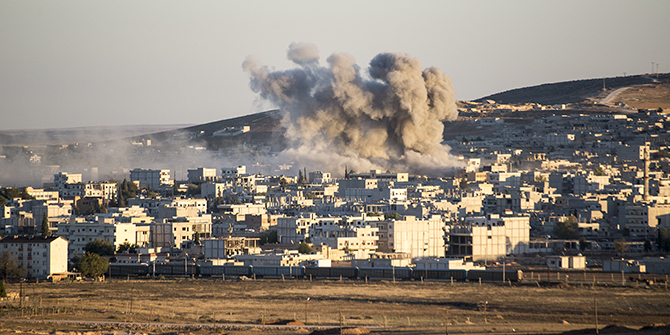By Dhruv Somayajula

Over a million migrants and asylum seekers sought refuge in Europe in 2015 – a record which sent the migration crisis to the forefront of the political and social agenda. Behind the crisis lie the large-scale internal conflicts or armed rebellions in countries such as Syria, Afghanistan, Somalia and Iraq. But in order to fully understand why so many are fleeing their native countries, we must examine the causes in more detail – looking in particular at the exponential increase in attacks on civilians, not just by internal parties, but also by third party states, both requested and unsolicited.
Statistics have shown that most of the refugees fleeing to the EU are from those countries directly affected by not just inter-state violence or civil conflict, but by third party violence caused by humanitarian interventions. For example, the number of asylum seekers from Syria to the EU since 2011 is close to 429,000. The Syrian refugee exodus began in April 2011, with the number of refugees rising to 1 million by March 2013. This number then doubled to over 2 million by September 2013. In September 2014, the US government announced the commencement of air strikes to combat the presence of ISIS. In that month alone, over 130,000 people fled Syria. Air strikes against ISIS have been continuing since, with additional support from the UK and France, and Russia joining in September 2015, which culminated in number of Syrian refugees today reaching 4.9 million. The refugee influx was initially focused on Syria’s neighbouring countries – Jordan, Lebanon and Turkey – but after nearing exhaustion of resources, these countries, not developed to accommodate the rising number of refugees, have stagnated, causing Syrian migrants to flee towards Europe. The spike in EU-bound migrants in 2015 indicates a correlation between the refugee exodus and the ‘humanitarian intervention’ being staged by global powers under the ‘Responsibility to Protect’ (R2P) idea.
It is crucial to note here the similarity between Syria and Afghanistan, around which the idea of R2P was born. Afghanistan had a Russian-backed regime which was overthrown by the Taliban, backed by Pakistan, while the CIA supplied arms to fighters who went on to form the Taliban regime. With the Taliban in power, the US then declared war on Afghanistan in 2001. An extension of the famous ‘war on terror’ ideology, this conflict was immensely destructive and has killed over 31,000 civilians since 2001. Air strikes continued even after US troops formally withdrew from the ground, with six civilians killed as collateral damage from a Taliban-aimed airstrike in 2016. Afghan refugees today form the second largest group of asylum seekers in Europe after Syria with 180,000 refugees, and, in both regions, there is a direct correlation between humanitarian intervention to eliminate a terrorist group and a spike in civilians fleeing the country. This is not to say that civilians are safer in the presence of terrorists, but only to illustrate the part played by intervening parties in the creation of chaos.
There exists a vacuum in determining the rights of parties affected by ‘humanitarian intervention’. To understand state responsibility, and to measure the extent of state culpability, we need to look at the General Assembly Resolution on ‘Responsibility of States for Internationally Wrongful Acts’, adopted in 2001 (cited with approval by the International Court of Justice in the Gabcikovo-Nagymaros case). Article 31 lays down the obligation of a state to make full reparations to another state for injury caused by an ‘internationally wrongful act’. What then is an internationally wrongful act? According to Article 3, an act by a state can be classified as internationally wrong if ‘it’s in violation of international law’. To examine the root of this definition, it is necessary to look at the UN Charter and general principles of international law.
The legal justification for ‘humanitarian intervention’ comes from Article 51 of the UN Charter, which declares an inherent right of collective self-defence if an armed attack occurs against a member state. The need for ‘necessity’ and ‘proportionality’ under the Articles of State Responsibility are based on Article 51, and have been used in the past (see paragraph 196 of the Security Council Meeting Records of July 1960) to justify military intervention in a foreign country. The UN Charter, and its predecessor, the PCIJ Statute, were created at a time when colonialism was a reality, and humanitarian intervention was flexibly interpreted by these powers for their benefit. Due to the influence of colonialism on the laws governing humanitarian intervention, ‘making good the loss’ for victims of the affected state has not been given the importance it deserves. The existing school of thought on humanitarian intervention needs a rethink.
Air strikes and arms support have been the primary method of indirect aid to quell rebellions in conflicted areas, and on occasion troops from powerful countries are deployed in these countries when the rebelling faction is having a larger effect on world politics in general. This article does not insist that humanitarian intervention is curtailed, nor argue that such intervention by third-party states is illegal. But while countries can legitimately ask for and provide military support in certain scenarios, this should be backed by a resolution to provide reparations for damages and deaths of civilians killed as collateral damage. Refugees are not born, but created during periods of grave adversity and extreme security deprivation. A short-term solution could be developed for the EU migration crisis by sending certain numbers of refugees to all EU countries by law. However, the controversial nature of that debate makes such a solution unlikely. In the long term, we should explore a system by which humanitarian intervention doesn’t terminate upon withdrawal of troops, but upon making reparations for damages of property, with accountability for civilian deaths.
Dhruv Somayajula is an undergraduate pursuing an LLB at NALSAR University of Law. His interests include human rights law and tech law, specifically violations of civil liberties. He tweets at @dhruv_som.






